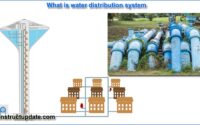What is Fresh Concrete and its Properties | 7 Properties of a Fresh Concrete
Fresh concrete refers to concrete that has been freshly mixed, has plasticity, and retains enough of its original workability to allow for placement, handling, consolidation, and finishing techniques that are intended. The new concrete must meet the specifications below:
- They must be simple to handle, transport, and move.
- It must maintain consistency throughout production.
- It should have flow characteristics that allow it to completely fill out the forms.
- They should be able to be thoroughly compacted with the least amount of compaction effort.
- It should have good qualities for flowability, mobility, and lumpability.
- During placement and consolidation, there shouldn’t be any segregation.
- They must be able to be appropriately finished.

7 Properties of a Fresh Concrete
- Workability of Fresh Concrete
- Segregation of Fresh Concrete
- Bleeding of Fresh Concrete
- Plastic shrinkage of Fresh Concrete
- Setting Time of Fresh Concrete
- The temperature of Fresh Concrete
- Water Cement Ratio (w/c) of Fresh Concrete
Workability of Fresh Concrete
The word “workability” describes how easily or difficultly the concrete is moved, positioned, and handled. The right proportion of water should be present in concrete.
For good workability, a higher water-cement ratio is typically needed. Water’s primary purpose is to lubricate concrete. Workable concrete is concrete that is simple to handle and erect.
The workability of the concrete mixture can be evaluated using a variety of tests. The workability of the concrete mixture is assessed using tests like the flow test, compacting test, and slump cone test.
Segregation of Fresh Concrete
The separation of the components that make up concrete is known as segregation. The separation of coarse particles from concrete is the first of three different forms of segregation.
Second, the coarse aggregates and cement paste are separating, and third, water is separating from the remainder of the mixture.
Due to its inhomogeneity and lack of acceptable qualities, this form of concrete is weak.
Concrete discharged from poorly built mixers and concrete dropped from heights both demonstrate a tendency toward segregation.
Segregation is the attempt of coarse particles to settle down as a result of excessive vibration in concrete.
Bleeding of Fresh Concrete
A specific type of segregation called bleeding occurs when some of the water within the concrete leaks out onto the surface.
Sand and cement particles are carried by the water as it rises to the surface, and these particles harden to produce a coating that is known as laitance.
Concrete that is improperly proportioned, excessively moist, and mixed insufficiently bleeds.
Prevention of bleeding in concrete
- When ingredients are mixed thoroughly and uniformly, bleeding can be reduced.
- By using pozzolanic materials that have been finely separated, a long way across the water can be crossed with little bleeding.
- The air-penetrating agent effectively lowers blood pressure.
- Using fine cement or cement with a low alkali component helps lessen bleeding.
Plastic shrinkage of Fresh Concrete
Fresh concrete experiences volumetric shrinkage when still in a plastic state after being poured in moulds (before the concrete set). Plastic shrinkage is the term for this.
Because the form was used while the concrete was still plastic, or had not yet set, this phenomenon is known as plastic shrinkage. The plastic concrete surface shrinks and cracks as a result of a rapid drying process. They rarely happen close to a slab’s margins because there, the concrete is frequently unconfined.
After 30 minutes of concrete pouring or during finishing, it may begin.
Setting Time of Fresh Concrete
Setting describes the transition of freshly laid concrete to a hardened condition. And the length of time needed to accomplish this process is referred to as the concrete setting time.
Concrete can have its setting time increased or decreased by adding an admixture, which depends on the type of cement used.
The temperature of Fresh Concrete
According to IS:7861, it is not advised to lay concrete at temperatures exceeding 40°C without taking the necessary safety precautions (part -1).
Concrete preparation, laying, and curing in hot temperatures present unique challenges. After installing new concrete, the first 24 to 72 hours are crucial.
Concrete undergoes hydration during this time, a chemical process that gives concrete its strength.
Concrete experiences strain and develop cracks if the temperature is not managed and rises above its maximum range during hydration.
Additionally, the hydration process slows down and concrete takes a long time to set if the temperature is below the minimum temperature.
It is important to realise that, unless the temperature is regulated, concrete can be poured at any temperature.
Water Cement Ratio (w/c) of Fresh Concrete
It refers to the proportion of cement to water used to prepare concrete. When mixing concrete, the amount of water utilised is crucial.
Water won’t be present in sufficient amounts to hydrate cement if the proportion of water utilised is lower. It will produce porous, fragile concrete.
Because of this, the typical tendency is to use too much water, which results in a mix that is more workable but weaker concrete. Aggregate segregation caused by excessive water yields porous concrete with low strength and density.
To completely hydrate the cement, a specific minimum amount of water is required. More water is required to make the concrete sufficiently workable to be positioned.
The ratio of water to cement in the mix determines the strength of the concrete as long as it is adequately workable for the method of placement.
The water-cement ratio should generally be kept as low as the methods of placement permit and shouldn’t go beyond the limits set for the different types of concrete.




